
Beta Lyrae officially named Sheliak, the traditional name of the system, is a multiple star system in the constellation of Lyra. Based on parallax measurements obtained during the Hipparcos mission, it is approximately 960 light-years distant from the Sun.

WR 22, also known as V429 Carinae or HR 4188, is an eclipsing binary star system in the constellation Carina. The system contains a Wolf-Rayet (WR) star that is one of the most massive and most luminous stars known, and is also a bright x-ray source due to colliding winds with a less massive O class companion.
HP Lyrae is a variable star in the constellation Lyra, with a visual magnitude varying between 10.2 and 10.8. It is likely to be an RV Tauri variable, an unstable post-AGB star losing mass before becoming a white dwarf.
LQ Andromedae is a variable star in the constellation Andromeda. Its maximum apparent visual magnitude is 6.5, placing it at the limit of the visibility to the naked eye. The brightness, however, drops down to 6.66 with a periodic cycle of roughly 7.44 hours.

WZ Andromedae is an eclipsing binary star in the constellation Andromeda. Its maximum apparent visual magnitude is 11.6, but drops down to 12.00 during the main eclipse which occurs roughly every 16.7 hours.
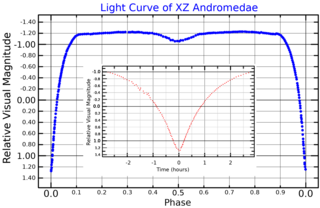
XZ Andromedae is a binary star in the constellation Andromeda. Its maximum apparent visual magnitude is 9.91, but drops down to 12.45 every 1.357 days. Its variability matches the behaviour of Algol variable stars.

AB Andromedae is a binary star in the constellation Andromeda. Its maximum apparent visual magnitude is 9.49 but shows a variation in brightness down to a magnitude of 10.46 in a periodic cycle of roughly 8 hours. The observed variability is typical of W Ursae Majoris variable stars, so the two stars in this system form a contact binary.
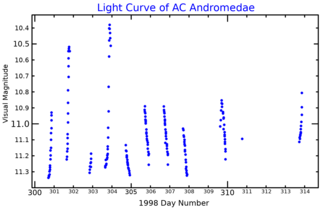
AC Andromedae is a variable star in the constellation Andromeda. Its maximum apparent visual magnitude is 10.77, but can be seen fainter down to a magnitude of 11.9.

AD Andromedae is an eclipsing binary in the constellation Andromeda. Its maximum apparent visual magnitude is 11.2, but it shows a decrease of 0.62 magnitudes during the main eclipse and 0.58 during the secondary one. It is classified as a Beta Lyrae variable star with a period of almost one day.

CC Andromedae is a variable star in the constellation Andromeda. It is a pulsating star of the Delta Scuti type, with an apparent visual magnitude that varies between 9.19 and 9.46 with a periodicity of 3 hours.
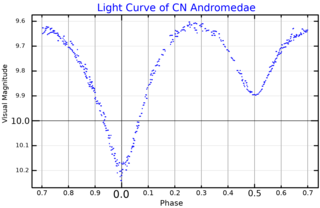
CN Andromedae is an eclipsing binary star in the constellation Andromeda. Its maximum apparent visual magnitude is 9.62 and drops down to a minimum of 10.2 during the main eclipse. It's classified as a Beta Lyrae variable with a period roughly of 0.4628 days.
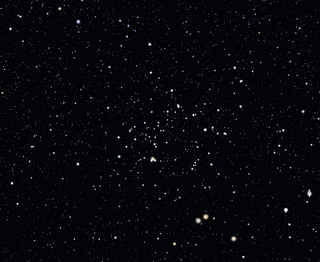
DS Andromedae is an eclipsing binary star in the constellation Andromeda and a member of the open cluster NGC 752. Its maximum apparent visual magnitude is 10.44, but drops down to 10.93 during the main eclipse and to 10.71 during the secondary one.
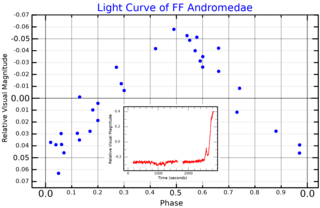
FF Andromedae is a spectroscopic binary in the constellation Andromeda. It has a typical apparent visual magnitude of 10.4, but undergoes flare events that can increase its brightness by about a magnitude.

HN Andromedae is a variable star in the constellation Andromeda. Its apparent visual magnitude varies between 6.67 and 6.76 in a cycle of 69.51 days. It is classified as an α2 Canum Venaticorum variable.
KX Andromedae is a spectroscopic binary star in the constellation Andromeda. Its apparent visual magnitude varies between 6.88 and 7.28.
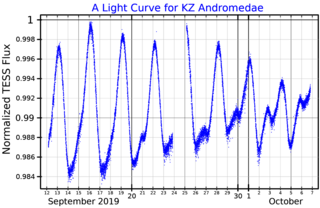
KZ Andromedae is a double lined spectroscopic binary in the constellation Andromeda. Its apparent visual magnitude varies between 7.91 and 8.03 during a cycle slightly longer than 3 days.

PX Andromedae is an eclipsing cataclysmic variable star in the constellation Andromeda. It has been classified as a SW Sextantis variable, and its apparent visual magnitude varies between 14.04 and 17.

QR Andromedae is an eclipsing binary star in the constellation Andromeda. Its maximum apparent visual magnitude is 12.16, but its light curve shows clearly eclipsing events where its brightness can drop to a magnitude of 13.07. This leads to its classification as an Algol variable star.
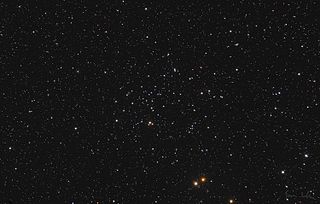
QX Andromedae is an eclipsing binary in the constellation Andromeda. It varies from a maximum apparent visual magnitude of 11.28 to a minimum of 11.50. Since it is impossible to specify the onset time of the eclipses, it is classified as a W Ursae Majoris variable star. It is also observed as an X-ray source and is a member of the open cluster NGC 752.

V455 Andromedae is a dwarf nova in the constellation Andromeda. It has a typical apparent visual magnitude of 16.5, but reached a magnitude of 8.5 during the only observed outburst.

















